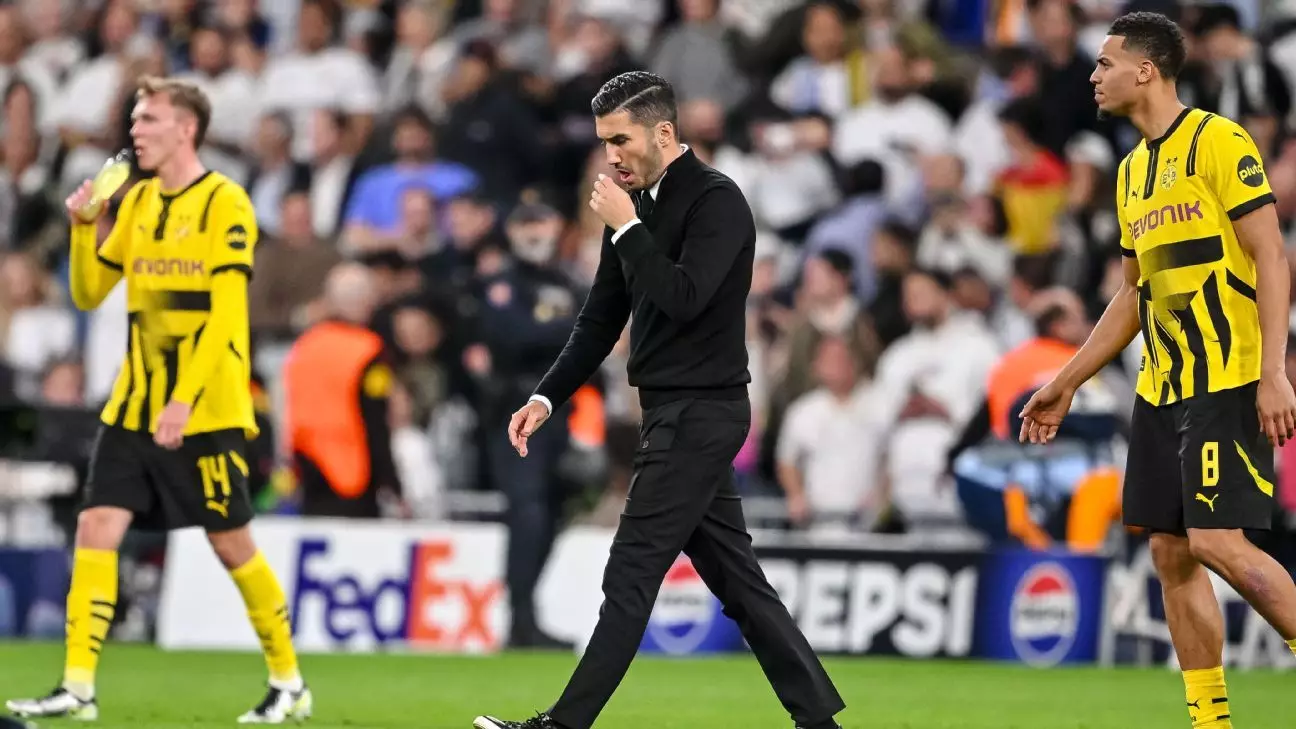The recent performance of Borussia Dortmund against Real Madrid has put the club’s current structural and strategic issues under the microscope. This unsatisfactory display highlights a more profound problem that extends beyond just a single match — it signifies the fragility and imbalance within the team. Dortmund’s encounter with Madrid, merely months after their loss in the UEFA Champions League final, serves as a sobering reminder of how precarious their situation is.
Dortmund began the match with a robust 4-2-3-1 formation, showcasing dominance in possession, successful challenges, and a solid lead with two early goals. However, the decision to switch to a 5-4-1 formation demonstrates a concerning lack of tactical coherence from the coaching staff, particularly under Nuri Şahin, who succeeded Edin Terzic. The introduction of Waldemar Anton in place of the attacking Jamie Gittens sent a clear signal of retreat, akin to signaling the opposing team to advance. This tactical shift not only compromised their attacking threats but proved to be a critical miscalculation that left the players scrambling against a talented and opportunistic Real Madrid squad.
The consequences of such tactical decisions became increasingly evident as Dortmund faltered defensively. When Emre Can was left to confront the likes of Vinícius Júnior one-on-one, it exposed their frail defensive line. The lapse in judgement from Şahin highlights not only the impact of leadership transitions but also the pressing need for a strategic overhaul. As a result, the team’s away form has become a glaring issue, with three consecutive losses and twelve goals conceded—a record that would instill fear in any coach.
Although their home performances show statistical superiority, those who have observed Dortmund play recognize that they’ve often labored through matches without convincing displays. The recent lackluster victory against St. Pauli only served to underscore their ongoing struggles. It appears the team is skating on thin ice, relying on late-game heroics rather than showcasing consistent performance.
In this light, Şahin faces a daunting task. While he may be partly responsible for the current tactical struggles, the broader context reveals that the squad’s shortcomings—largely stemming from a disjointed recruiting strategy—have created an unstable environment. The responsibility extends beyond the pitch, landing squarely on the shoulders of management figures like Lars Ricken and Sebastian Kehl, whose lack of coherence in player acquisitions stands in stark contrast to their Bundesliga competitors.
Dortmund’s recruitment strategy has seemingly lost its edge since the days when the club successfully attracted and nurtured standout talents like Erling Haaland and Jude Bellingham. In recent times, however, their transfer dealings have lacked the clarity and vision seen in clubs like Bayern Munich or RB Leipzig. This leaves Dortmund at risk of becoming a mid-table team rather than challenging for the championship and further European glory.
Amid these troubles, clubs like Stuttgart have demonstrated resilience. Their recent victory over Juventus has reignited hopes and provided a welcome distraction from the tumult faced by their domestic counterparts, particularly Dortmund. Stuttgart’s knack for blending promising players into a cohesive unit contrasts sharply with Dortmund’s struggles, emphasizing the broader themes of successful management and tactical clarity within the Bundesliga.
Similarly, Bayern Munich’s own inconsistency under new management has raised questions about their tactical decisions against high-level teams. Despite having immense talent, their recent performances against opponents like Barcelona highlight vulnerabilities that could hinder their aspirations for another Champions League title.
If Dortmund remains static and fails to find a way out of this current predicament, they will need a miracle — not just on the pitch but across their organizational structure. With the Bundesliga season in full swing and pressure mounting, the club must decide whether they will settle for mediocrity or strive for greatness.
Ongoing fluctuations in performance, poor recruitment policies, and questionable tactical decisions beg for a comprehensive review of their approach. As they head into matches against teams like FC Augsburg, the urgency for a strategic recalibration becomes increasingly critical. The ambitious prospects that once characterized Borussia Dortmund now seem overshadowed by uncertainty. Without substantial enhancements and a clearer vision, their hopes to reclaim their standing as a dominant force in German and European football may soon be just that — hopes.

